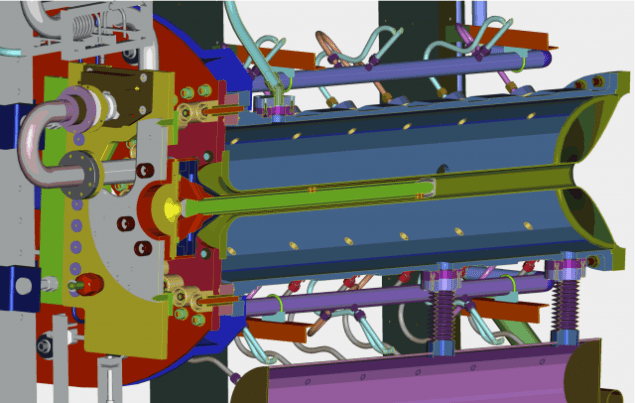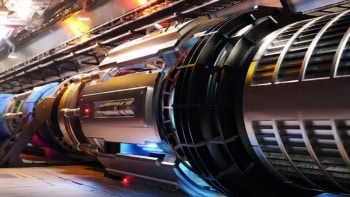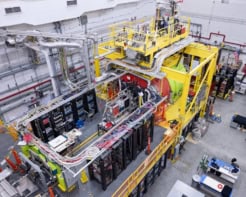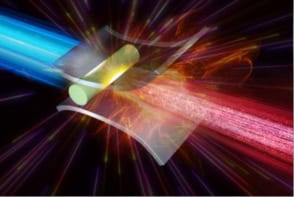
Physicists operating a huge detector in Japan have confirmed previous hints that neutrinos behave differently to their antimatter counterparts. The researchers, who make up the T2K collaboration, point out that it is still too early to claim discovery of the long-sought leptonic charge-parity (CP) violation. But they say that the latest results impose the strongest constraints yet on the type of matter-antimatter imbalance that neutrinos can experience.
CP violation was introduced by Andrei Sakharov in 1967 as a way of explaining why the universe (or at least the part visible to us) appears to consist almost entirely of matter even though equal quantities of matter and antimatter ought to have been produced in the Big Bang. Previously it had been thought that particles and antiparticles would always behave in exactly the same way if their spatial coordinates were reversed. But Sakharov posited that this symmetry was broken in the early universe.
Such an asymmetry has been observed in the decays of certain quark-containing particles, namely kaons and B-mesons. However, the amount of CP violation observed in these processes is far too small to explain the huge imbalance that exists between matter and antimatter.
Very heavy neutrinos
The nearly 500-strong international T2K collaboration is investigating whether the shortfall might in fact be made up by neutrinos, which are leptons. The idea is that the decay of very heavy neutrinos shortly after the Big Bang would have yielded the CP violation needed to generate a matter-dominated universe.
Neutrinos come in three flavours – electron, muon and tau – and oscillate from one flavour to another as they travel through space as a result of their tiny but finite mass. CP-violation would mean muon neutrinos transform into electron neutrinos more readily than muon antineutrinos morph into electron antineutrinos, or vice-versa.
T2K uses a neutrino beam generated at the Japan Proton Accelerator Research Complex (J-PARC) in Tokai on the east coast of Japan. Energetic protons strike a graphite target to create pions and kaons, which decay to create muon neutrinos and muon antineutrons. The source can be adjusted to create beams that are mostly muon neutrinos or mostly muon antineutrinos.
Extremely pure water
The neutrinos are sent through the ground (which offers little resistance to neutrinos) towards the Super-Kamiokande detector underneath a mountain in Kamioka, nearly 300 km to the west. The detector comprises 50,000 tonnes of extremely pure water, within which a small fraction of neutrinos will interact with neutrons to produce Cherenkov light that is picked up by an array of 13,000 photomultiplier tubes.
Because electron neutrinos and antineutrinos cannot be measured simultaneously, the experiment is first run in “neutrino mode” and then switched to “antineutrino mode”. However, in both cases the detector and beam lines consist entirely of matter, as opposed to antimatter, which tends to bias the results in favour of enhanced neutrino, rather than antineutrino, oscillation. As such, the collaboration has to correct its measured results to identify any CP violation, which it does using data from magnetized detectors positioned near the graphite target at the source in Tokai.
Analysing events recorded between 2009 and 2018, the researchers report in Nature that they observed 90 electron neutrinos and just 15 electron antineutrinos. Even allowing for the effect of the purely matter-based components, this major imbalance points to CP-violation in neutrinos, they say. Indeed, the results suggest an almost maximum bias towards matter and comes close to excluding any favouring of antimatter. Zero asymmetry between the two is ruled out with a confidence of 95%, as was the case when the collaboration last published an analysis in 2017.
“Undeniably exciting”
In a commentary piece to accompany the paper in Nature, Silvia Pascoli of Durham University in the UK and Jessica Turner of Fermilab in the US write that the “undeniably exciting” results could represent “the first indications” of a solution to the universe’s matter–antimatter asymmetry. But they argue that a true discovery of leptonic CP violation will require “more intense beams, larger detectors and better-understood experimental features”.

Japan pushes ahead for Hyper-Kamiokande neutrino detector
The T2K collaboration plans next to reduce systematic uncertainties by upgrading the magnetized detectors as well as collecting more data, while J-PARC intends to upgrade the accelerator and beamline in order to raise the intensity of the beam. T2K spokesperson, Atsuko Ichikawa of Kyoto University in Japan, says that the collaboration plans to carry out the upgrade within the next two years, although she adds that the schedule might slip due to the coronavirus pandemic.
Super-Kamiokande should then be superseded by the much bigger Hyper-Kamiokande. More than 70 m deep and nearly 70 m wide, Hyper-K will contain 260,000 tonnes of ultrapure water – allowing researchers to make more precise probes of CP-violation as well as look for proton decay. The project was approved officially by Japan in February and is due to start operating in 2027, but here too, says Ichikawa, the virus could lead to delays.
Also this decade researchers hope to switch on the Deep Underground Neutrino Experiment at the Sanford Lab in South Dakota, US. This will use several thousand tonnes of liquid argon to intercept a neutrino beam that has travelled 1300 km from Fermilab in Illinois.



